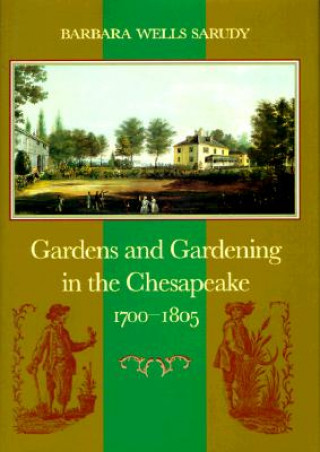
Doručenie
Nákupný poradca





Nehodí sa? Žiadny problém! U nás môžete do 30 dní vrátiť
 Darčekový poukaz
v ľubovoľnej hodnote
Darčekový poukaz
v ľubovoľnej hodnote
S darčekovým poukazom nešliapnete vedľa. Obdarovaný si za darčekový poukaz môže vybrať čokoľvek z našej ponuky.
Gardens and Gardening in the Chesapeake, 1700-1805
 Angličtina
Angličtina
 157 b
157 b
30 dní na vrátenie tovaru
Mohlo by vás tiež zaujímať


The mid-Atlantic region is fortunate to have an abundance of houses and buildings that date to the eighteenth century. Fine examples of the furniture, paintings, and other objects that filled these houses survive in museums and private collections. But what of the gardens that surrounded these early homes? Virtually all of them have been reclaimed by wilderness or altered by later residents. In Gardens and Gardening in the Chesapeake, Barbara Wells Sarudy recovers this lost world using a remarkable variety of sources-historic maps, travelers' accounts, diaries, paintings (some on the backs of Baltimore painted chairs), account ledgers, catalogues, and newspaper advertisements. She offers an engaging account of the region's earliest gardens, introducing us to the people who designed and tended these often elaborate landscapes and explaining the forces and finances behind their creation. Many of Sarudy's stories concern the gentry and their great estates. She tells of Charles Carroll of Annapolis, who spent the 1770s fretting about revolutionary politics and designing geometric landscapes for his home-and who died in 1783, the result of a fall in his beloved garden. She describes Charles Ridgely's terraced garden at Hampton, one of more than seventy geometric gardens that dotted the hills around Baltimore in the 1800s. And she recalls Rosalie Stier Calvert's quest for beauty and utility in her garden at Riversdale, where at great expense she ordered the installation of an ornamental lake to improve the view while also providing ice for the kitchen and fish for the table. Beyond the gentry, Sarudy tells the less familiar stories of the gardeners, laborers, nurserymen, and seed dealers whose skills and efforts transformed the Chesapeake landscape. In Virginia, royal gardeners arrived from England to maintain the grounds of the Governor's Palace and the College of William and Mary. In Maryland, the Jesuits paid independent garden contractors to maintain their kitchen and medicinal-botanical gardens. Most Chesapeake gardeners, of course, relied on indentured servants or slaves to install and maintain their gardens-or did the work themselves-and Sarudy tells their stories, as well. Throughout, she relates gardens and gardening to the larger forces that lay behind them. During the Revolution, for example, attempts to demonstrate republican simplicity and independence helped to create a distinctly American garden style. William Faris, an Annapolis watchmaker and innkeeper, went so far as to describe his improved varieties of tulips as symbols of the new nation-and took particular pride in naming them to honor national heroes such as President Washington. From the favorite books of early gardeners to the republican balance between table and ornamental gardens, Sarudy includes details that give us an unprecedented understanding of Chesapeake gardening from settlement through the early national period. Her postscript describes the ultimate fate of the region's eighteenth century gardens-some of which survive (in more or less authentic form) and can still be visited and enjoyed.
Informácie o knihe
 Angličtina
Angličtina




 Ako nakupovať
Ako nakupovať





























